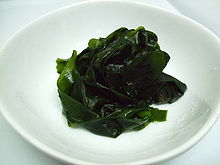Wakame
| Wakame (Undaria pinnatifida) | |
|---|---|
 |
|
| Scientific classification | |
| (unranked): | SAR |
| Superphylum: | Heterokonta |
| Class: | Phaeophyceae |
| Order: | Laminariales |
| Family: | Alariaceae |
| Genus: | Undaria |
| Species: | U. pinnatifida |
| Binomial name | |
|
Undaria pinnatifida (Harvey) Suringar, 1873 |
|
| Nutritional value per 100 g (3.5 oz) | |
|---|---|
| Energy | 188 kJ (45 kcal) |
|
9.14 g
|
|
| Sugars | 0.65 g |
| Dietary fiber | 0.5 g |
|
0.64 g
|
|
|
3.03 g
|
|
| Vitamins | |
| Thiamine (B1) |
(5%)
0.06 mg |
| Riboflavin (B2) |
(19%)
0.23 mg |
| Niacin (B3) |
(11%)
1.6 mg |
| Pantothenic acid (B5) |
(14%)
0.697 mg |
| Folate (B9) |
(49%)
196 μg |
| Vitamin C |
(4%)
3 mg |
| Vitamin E |
(7%)
1 mg |
| Vitamin K |
(5%)
5.3 μg |
| Minerals | |
| Calcium |
(15%)
150 mg |
| Iron |
(17%)
2.18 mg |
| Magnesium |
(30%)
107 mg |
| Manganese |
(67%)
1.4 mg |
| Phosphorus |
(11%)
80 mg |
| Sodium |
(58%)
872 mg |
| Zinc |
(4%)
0.38 mg |
|
|
|
|
|
| Percentages are roughly approximated using US recommendations for adults. Source: USDA Nutrient Database |
|
Wakame ( wakame?), Undaria pinnatifida, is a sea vegetable, or edible seaweed. It has a subtly sweet flavour and is most often served in soups and salads.
Sea-farmers have grown wakame in Japan since the Nara period. The Invasive Species Specialist Group has listed Undaria pinnatifida on its list of 100 worst globally invasive species.
The name "wakame" was derived from the Japanese name wakame (ワカメ, わかめ, 若布, 和布).
In Old Japanese, me stood for edible seaweeds in general as opposed to mo standing for algae. In kanji, such as 海藻, 軍布 and 和布 were applied to transcribe the word. Among seaweeds, wakame was likely most often eaten, therefore me especially meant wakame. It expanded later to other seaweeds like kajime, hirome (kombu), arame, etc. Wakame is derived from waka + me (若布, lit. young seaweed). If this waka is an eulogistic prefix, same as the tama of tamagushi, wakame likely stood for seaweeds widely in ancient ages. In Man'yōshū, in addition to 和可米 and 稚海藻 (both are read as wakame), nigime (和海藻, soft wakame) can be seen. Besides, tamamo (玉藻, lit. beautiful algae), which often appeared in Man'yo-shu, may be wakame depending on poems.
The earliest appearance in Western documents is probably in Nippo Jisho (1603), as Vacame.
In 1867 the word "wakame" appeared in an English-language publication, A Japanese and English Dictionary, by James C. Hepburn.
Starting in the 1960s, the word "wakame" started to be used widely in the United States, and the product (imported in dried form from Japan) became widely available at natural food stores and Asian-American grocery stores, due to the influence of the macrobiotic movement, and in the 1970s with the growing number of Japanese restaurants and sushi bars.
...
Wikipedia
